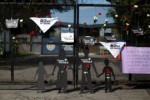Fire-ravaged Los Angeles confronts difficult questions as it rushes to rebuild
As a charred Los Angeles resurfaces from the infernal flames that engulfed the region last month, questions loom as to how residents will rebuild — and whether they should remake their neighborhoods as they were, or take the chance to make the city less vulnerable to the fires of the future.
With an estimated 17,000 structures burned in Eaton and Palisades fires — and ensuing economic losses estimated at more than $250 billion — reconstruction efforts will face monumental challenges from every angle: planning, permitting, supply chains, workforce and insurance.
State and local officials have been trying to unload some of the burden and streamline the process by minimizing bureaucracy where possible.
But experts remain skeptical as to just how quickly that construction should — or even could — occur, amid massive debris pileups and in neighborhoods that have become increasingly vulnerable to future wildfires.
“The ‘like for like’ policy is driven by the emotional needs of homeowners and the political needs of those who have devised the policy,” Char Miller, director of environmental analysis at Pomona College, told The Hill.
Although Miller acknowledged the psychology behind such an approach, he cautioned that allowing those who have the financial resources to rebuild in the same way as they previously have could lead to similar wildfire events in the years to come.
“That strikes me as a really bad policy, since governments are supposed to be stewarding, managing, securing the people's health and welfare,” Miller said. “This seems to be a policy that does the exact reverse of that."
Clearing the rubble, and the red tape
Officials are working to remove both physical and regulatory obstacles so the process of rebuilding can start — quickly.
California Gov. Gavin Newsom's (D) office announced last week that state, local and federal partners began structural debris removal efforts — building on the Environmental Protection Agency's ongoing work to eliminate household hazardous waste.
Both the Federal Emergency Management Agency and the U.S. Army Corps of Engineers began private property debris removal on Tuesday in Altadena and Pacific Palisades, the areas affected by the Eaton and Palisades fires, respectively.
To help expedite the process, the Los Angeles County Department of Public Works, together with the six relevant local jurisdictions, collected right-of-entry forms from residents, developed haul routes and coordinated the transport of ash and debris, the governor's office stated.
Also last week, Newsom on Thursday issued his........© The Hill






















 Toi Staff
Toi Staff Gideon Levy
Gideon Levy Jeffrey Bernstein Ph.d
Jeffrey Bernstein Ph.d Tarik Cyril Amar
Tarik Cyril Amar Moussa Ibrahim
Moussa Ibrahim Belen Fernandez
Belen Fernandez Penny S. Tee
Penny S. Tee Muhannad Ayyash
Muhannad Ayyash John Nosta
John Nosta Andrew Silow-Carroll
Andrew Silow-Carroll Sharona Margolin Halickman
Sharona Margolin Halickman
